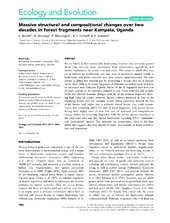Massive structural and compositional changes over two decades in forest fragments near Kampala, Uganda
Peer reviewed, Journal article
Published version

Åpne
Permanent lenke
http://hdl.handle.net/1956/12391Utgivelsesdato
2013Metadata
Vis full innførselSamlinger
Originalversjon
https://doi.org/10.1002/ece3.747Sammendrag
Private forests harbor considerable biodiversity, however, they are under greater threat than reserved areas, particularly from urbanization, agriculture, and intense exploitation for timber and fuel wood. The extent to which they may act as habitats for biodiversity and how level of protection impacts trends in biodiversity and forest structure over time remain underresearched. We contribute to filling this research gap by resampling a unique data set, a detailed survey from 1990 of 22 forests fragments of different ownership status and level of protection near Kampala, Uganda. Eleven of the 22 fragments were lost over 20 years, and six of the remnants reduced in size. Forest structure and composition also showed dramatic changes, with six of the remnant fragments showing high temporal species turnover. Species richness increased in four of the remaining forests over the resample period. Forest ownership affected the fate of the forests, with higher loss in privately owned forests. Our study demonstrates that ownership affects the fate of forest fragments, with private forests having both higher rates of area loss, and of structural and compositional change within the remaining fragments. Still, the private forests contribute to the total forest area, and they harbor biodiversity including IUCN “vulnerable” and “endangered” species. This indicates the conservation value of the fragments and suggests that they should be taken into account in forest conservation and restoration.
